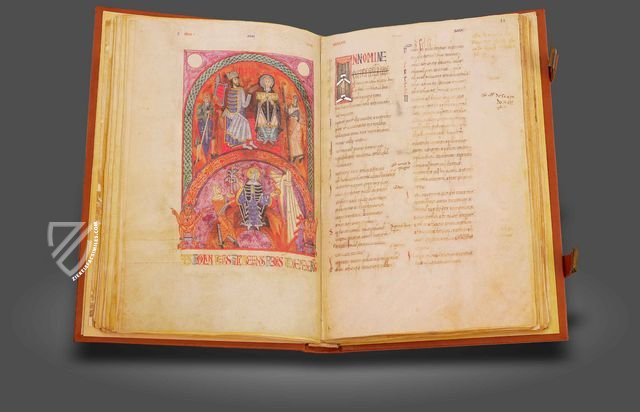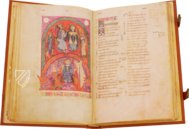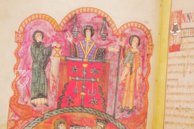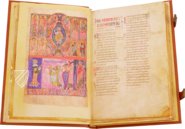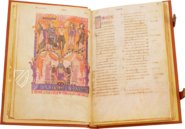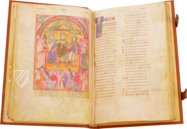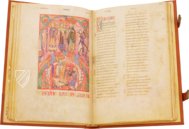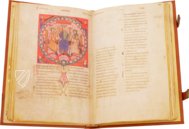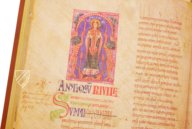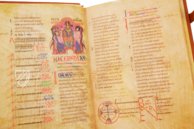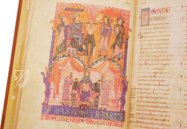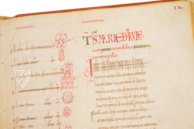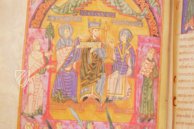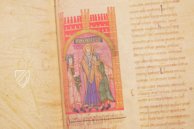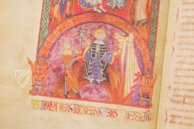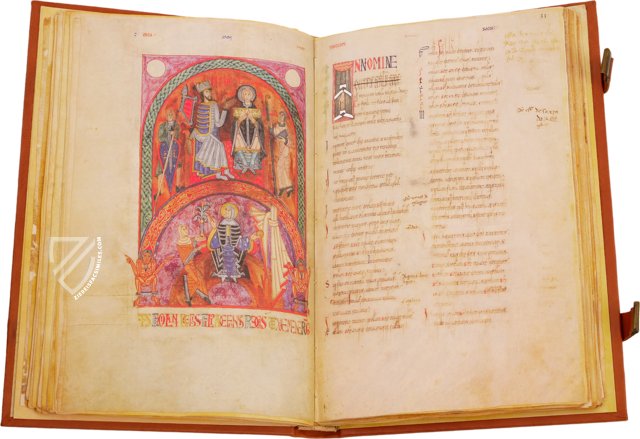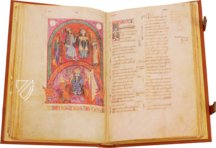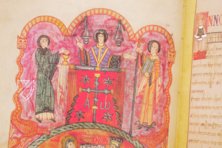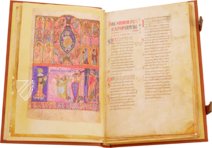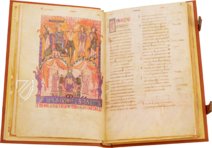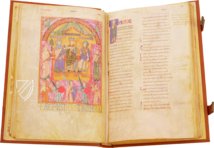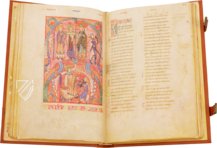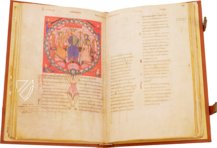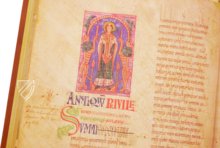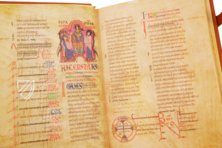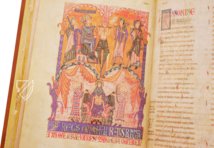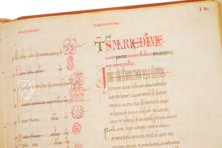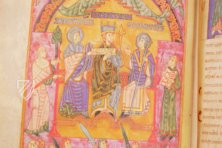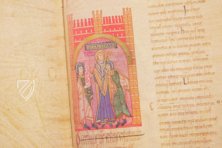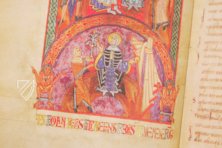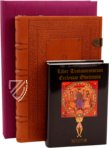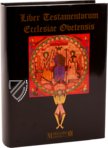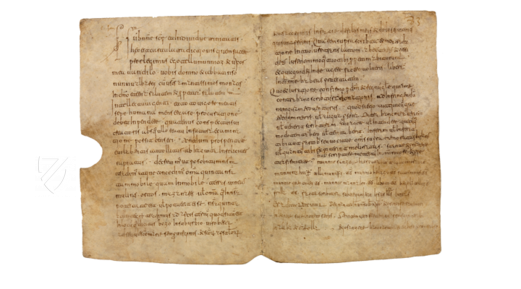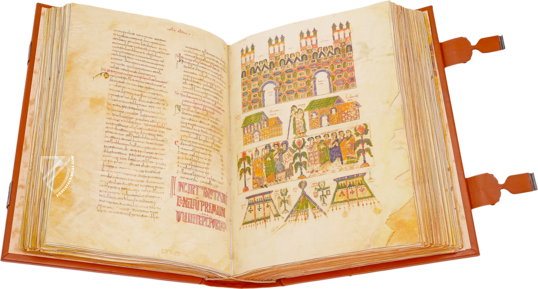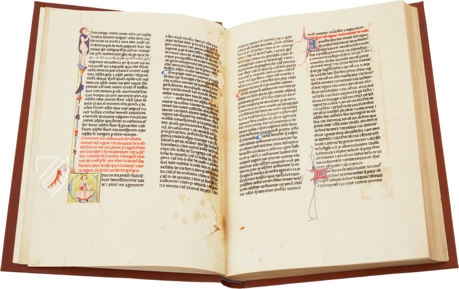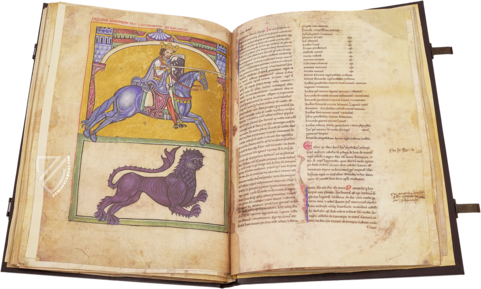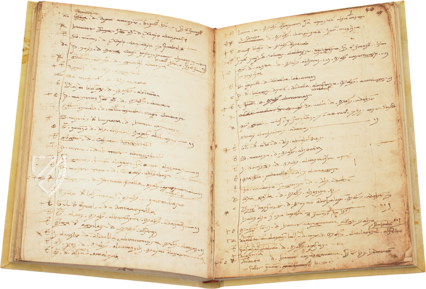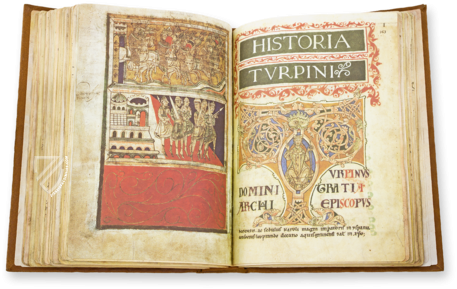Book of Testaments
(3,000€ - 7,000€)
The Book of Testaments is compilation of legal and historical documents relating to the Cathedral of Oviedo that originated between 1109 and 1118. It was commissioned by Bishop Pelagius in the municipality of Oviedo, Spain and contains historically valuable information about medieval life in Spain. 17 full- and half-page miniatures including depictions of various kings modelled on Evangelist portraits as well as vignettes and historiated initials make the manuscript especially artistically appealing. They were created using expensive pigments as well as gold and silver – no expense was spared – and represent a stylistic fusion of Carolingian, Insular, and Iberian influences. As such, the Book of Testaments is simultaneously a precious historical resource as well as a splendid work of art.
Book of Testaments
In the Middle Ages, France and Belgium were considered to be true strongholds of European painting and book art. Nevertheless in Spain in the early 12th century, there arose a few breath-taking codices that were in no way inferior to French and Belgian works of art. One of these masterpieces is the Book of Testaments, which has earned the gifted anonymous artist responsible for it the name of convenience Master of the Book of Testaments among art historians. This magnificent manuscript has remained in the archives of the Cathedral of Oviedo in Asturias for more than 900 years, greatly simplifying the manuscript’s history of ownership. Aside from records concerning Oviedo specifically, the cartulary is also a precious record that presents information about life in medieval Spain in the most detailed manner.
At the Behest of the Bishop
The illuminated manuscript was commissioned in the early-12th century by Bishop Pelagius of Oviedo (d. 1153), also known as Pelayo. It cannot be said for certain today who was responsible for the design of the codex but there is evidence of two copyists at work, one of which must have been one of the cathedral canons who was also, confusingly, named Pelagius: Pelagius Rosello, Pelagius Viello, or Pelagius Enniguiz. In terms of codicology and artistry, it seems likely that the work was undertaken as Oviedo Cathedral itself, the library holdings of which would have provided numerous templates for its creation.
The Important of Oviedo
The Book of Testaments contains information from documents spanning the years 808 to 1118, which are concerned with the diocese of Oviedo, which had previously enjoyed power and influence as the spiritual capital of Spain and political capital of the Kingdom of Asturias. These documents were written in a variety of Insular and continental scripts. In the codex, the donations of the congregation, tax exemptions, privileges of the church, and additional legal documents were recorded. The register of wealthy inhabitants of Oviedo who made the construction of the splendid cathedral possible through their generous donations is also very interesting. However, many of the royal charters from the kings of Asturias and León were forgeries created by Bishop Pelagius, earning him the nickname el Fabulador or "the Fabulist", as part of an effort to assert the independence of Oviedo from the archbishops of Toledo and Santiago. This does not appear to have been done for his own benefit but to restore the privileged status of the diocese of Oviedo.
Innovative Illustrations
This manuscript contains 17 high quality miniatures including 8 full-pages and 9 half-pages and is embellished with numerous historiated initials and décor in the margins. Alongside its historically significant content, the codex impresses through its miniatures, true masterpieces of Spanish Romanesque illumination. They display a characteristic painting style as is seen in no other manuscript from Europe. Modelled on Evangelist portraits, full-page miniatures depict King Alfonso II of Asturias (ca. 760 – 842), a certain Archbishop Adolfo, King Ordoño I of Asturias (ca. 821–866), King Ordoño II of Galicia and León (ca. 873–924), and Alfonso V of León (ca. 994–1028) but the portraits of King Ferdinand I of León (c. 1015–65) and King Alfonso VI of León and Castile (1040/41–1109) are missing. The Book of Testaments already caused a stir at its creation – its influence can be seen in Tumbo A of Santiago de Compostela and the Libro de las Estampas of León – and has lost none of its artistic appeal today.
Codicology
- Alternative Titles
- Libro de los Testamentos
Liber testamentorum ecclesiae ovetensis
Buch der Testamente
Libro dei Testamenti
Livre des Testaments
Livro dos Testamentos
Libro Notarial de Don Pelayo, Obispo de Oviedo - Size / Format
- 226 pages / 36.4 × 24.0 cm
- Origin
- Spain
- Date
- 1109–1112
- Epochs
- Style
- Language
- Script
- Carolingian minuscule Protogothic minuscule
- Illustrations
- 17 miniatures plus illuminated initials and marginal decorations
- Content
- The Cathedral of Oviedo's most important documents
- Patron
- Don Pelayo, Bishop of Oviedo
- Artist / School
- Master of the Book of Testaments (illuminator)
Sub-Deacon Pelagius (illuminator)
Bishop Pelayo (illuminator and scribe)
Book of Testaments
Ordoño I
Labelled in purple and gold as ORDONI REX, King Ordoño I of Asturias (ca. 821–866) is depicted crowned, enthroned, and accompanied by a squire carrying his arms. The archbishops Serenus and Ovecus stand to the right with gold and silver halos and are labelled in red; the former holds a document with his royally granted privileges. What makes this image truly remarkable is the highly expressive human figure that has been incorporated into the central column supporting the two arches.
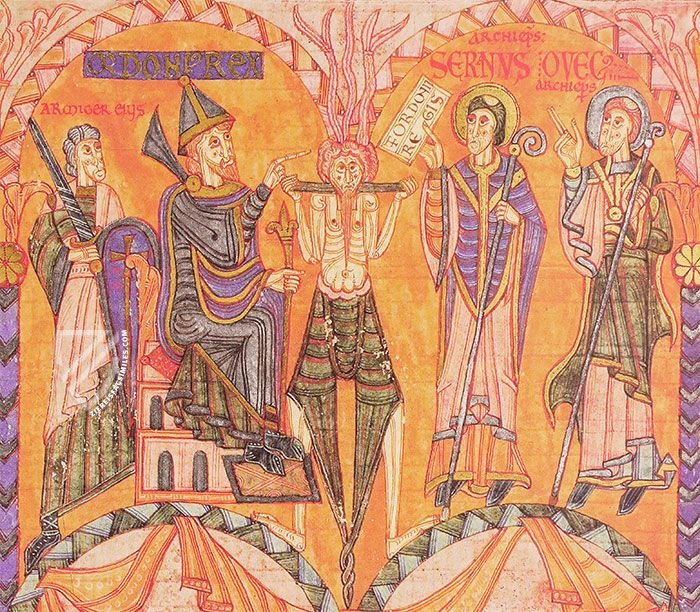
Book of Testaments
Alfonso II
King Alfonso II of Asturias (ca. 760 – 842) is depicted kneeling in the lower register with his hands raised in a pious gesture. Accompanied by a squire carrying his arms, he is crowned and elaborately dressed in silver and gold. The Virgin Mary appears on the left with a golden halo and the Archangel Michael is depicted with a silver halo slaying the dragon on the right.
Christ, surrounded by angels, is enthroned in a mandorla and gives the sign of benediction in the upper register. The Twelve Apostles appear in arched frames with St. Peter holding his key on the right alongside St. John. It is a similar image to the front panel of the Arca Santa, a silver-gilt oak reliquary in Oviedo Cathedral, for which Alfonso “the Chaste” had a chapel constructed.
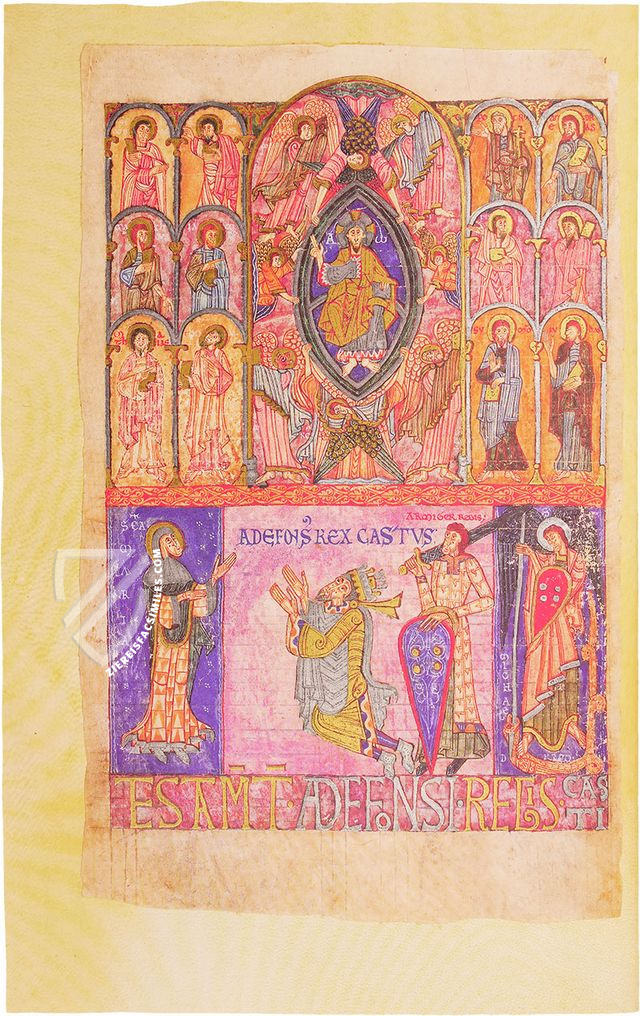
#1 Libro de los Testamentos
Language: Spanish
(3,000€ - 7,000€)
- Treatises / Secular Books
- Apocalypses / Beatus
- Astronomy / Astrology
- Bestiaries
- Bibles / Gospels
- Chronicles / History / Law
- Geography / Maps
- Saints' Lives
- Islam / Oriental
- Judaism / Hebrew
- Single Leaf Collections
- Leonardo da Vinci
- Literature / Poetry
- Liturgical Manuscripts
- Medicine / Botany / Alchemy
- Music
- Mythology / Prophecies
- Psalters
- Other Religious Books
- Games / Hunting
- Private Devotion Books
- Other Genres
- Afghanistan
- Armenia
- Austria
- Belgium
- Belize
- Bosnia and Herzegovina
- China
- Colombia
- Costa Rica
- Croatia
- Cyprus
- Czech Republic
- Denmark
- Egypt
- El Salvador
- Ethiopia
- France
- Germany
- Greece
- Guatemala
- Honduras
- Hungary
- India
- Iran
- Iraq
- Israel
- Italy
- Japan
- Jordan
- Kazakhstan
- Kyrgyzstan
- Lebanon
- Liechtenstein
- Luxembourg
- Mexico
- Morocco
- Netherlands
- Palestine
- Panama
- Peru
- Poland
- Portugal
- Romania
- Russia
- Serbia
- Spain
- Sri Lanka
- Sweden
- Switzerland
- Syria
- Tajikistan
- Turkey
- Turkmenistan
- Ukraine
- United Kingdom
- United States
- Uzbekistan
- Vatican City
- A. Oosthoek, van Holkema & Warendorf
- Aboca Museum
- Ajuntament de Valencia
- Akademie Verlag
- Akademische Druck- u. Verlagsanstalt (ADEVA)
- Aldo Ausilio Editore - Bottega d’Erasmo
- Alecto Historical Editions
- Alkuin Verlag
- Almqvist & Wiksell
- Amilcare Pizzi
- Andreas & Andreas Verlagsbuchhandlung
- Archa 90
- Archiv Verlag
- Archivi Edizioni
- Arnold Verlag
- ARS
- Ars Magna
- ArtCodex
- AyN Ediciones
- Azimuth Editions
- Badenia Verlag
- Bärenreiter-Verlag
- Belser Verlag
- Belser Verlag / WK Wertkontor
- Benziger Verlag
- Bernardinum Wydawnictwo
- BiblioGemma
- Biblioteca Apostolica Vaticana (Vaticanstadt, Vaticanstadt)
- Bibliotheca Palatina Faksimile Verlag
- Bibliotheca Rara
- Boydell & Brewer
- Bramante Edizioni
- Bredius Genootschap
- Brepols Publishers
- British Library
- C. Weckesser
- Caixa Catalunya
- Canesi
- CAPSA, Ars Scriptoria
- Caratzas Brothers, Publishers
- Carus Verlag
- Casamassima Libri
- Centrum Cartographie Verlag GmbH
- Chavane Verlag
- Christian Brandstätter Verlag
- Circulo Cientifico
- Club Bibliófilo Versol
- Club du Livre
- CM Editores
- Collegium Graphicum
- Collezione Apocrifa Da Vinci
- Comissão Nacional para as Comemorações dos Descobrimentos Portugueses
- Coron Verlag
- Corvina
- CTHS
- D. S. Brewer
- Damon
- De Agostini/UTET
- De Nederlandsche Boekhandel
- De Schutter
- Deuschle & Stemmle
- Deutscher Verlag für Kunstwissenschaft
- DIAMM
- Droz
- E. Schreiber Graphische Kunstanstalten
- Ediciones Boreal
- Ediciones Grial
- Ediclube
- Edições Inapa
- Edilan
- Editalia
- Edition Deuschle
- Edition Georg Popp
- Edition Leipzig
- Edition Libri Illustri
- Editiones Reales Sitios S. L.
- Éditions de l'Oiseau Lyre
- Editions Medicina Rara
- Editorial Casariego
- Editorial Mintzoa
- Editrice Antenore
- Editrice Velar
- Edizioni Edison
- Egeria, S.L.
- Eikon Editores
- Electa
- Emery Walker Limited
- Enciclopèdia Catalana
- Eos-Verlag
- Ephesus Publishing
- Ernst Battenberg
- Eugrammia Press
- Extraordinary Editions
- Fackelverlag
- Facsimila Art & Edition
- Facsimile Editions Ltd.
- Facsimilia Art & Edition Ebert KG
- Faksimile Verlag
- Feuermann Verlag
- Folger Shakespeare Library
- Franco Cosimo Panini Editore
- Friedrich Wittig Verlag
- Fundación Hullera Vasco-Leonesa
- G. Braziller
- Gabriele Mazzotta Editore
- Gebr. Mann Verlag
- Gesellschaft für graphische Industrie
- Getty Research Institute
- Giovanni Domenico de Rossi
- Giunti Editore
- Graffiti
- Grafica European Center of Fine Arts
- Guido Pressler
- Guillermo Blazquez
- Gustav Kiepenheuer
- H. N. Abrams
- Harrassowitz
- Harvard University Press
- Helikon
- Hendrickson Publishers
- Henning Oppermann
- Herder Verlag
- Hes & De Graaf Publishers
- Hoepli
- Holbein-Verlag
- Houghton Library
- Hugo Schmidt Verlag
- Idion Verlag
- Il Bulino, edizioni d'arte
- ILte
- Imago
- Insel Verlag
- Insel-Verlag Anton Kippenberger
- Instituto de Estudios Altoaragoneses
- Instituto Nacional de Antropología e Historia
- Introligatornia Budnik Jerzy
- Istituto dell'Enciclopedia Italiana - Treccani
- Istituto Ellenico di Studi Bizantini e Postbizantini
- Istituto Geografico De Agostini
- Istituto Poligrafico e Zecca dello Stato
- Italarte Art Establishments
- Jan Thorbecke Verlag
- Johnson Reprint Corporation
- Josef Stocker
- Josef Stocker-Schmid
- Jugoslavija
- Karl W. Hiersemann
- Kasper Straube
- Kaydeda Ediciones
- Kindler Verlag / Coron Verlag
- Kodansha International Ltd.
- Konrad Kölbl Verlag
- Kurt Wolff Verlag
- La Liberia dello Stato
- La Linea Editrice
- La Meta Editore
- Lambert Schneider
- Landeskreditbank Baden-Württemberg
- Leo S. Olschki
- Les Incunables
- Liber Artis
- Library of Congress
- Libreria Musicale Italiana
- Lichtdruck
- Lito Immagine Editore
- Lumen Artis
- Lund Humphries
- M. Moleiro Editor
- Maison des Sciences de l'homme et de la société de Poitiers
- Manuscriptum
- Martinus Nijhoff
- Maruzen-Yushodo Co. Ltd.
- MASA
- Massada Publishers
- McGraw-Hill
- Metropolitan Museum of Art
- Militos
- Millennium Liber
- Müller & Schindler
- Nahar - Stavit
- Nahar and Steimatzky
- National Library of Wales
- Neri Pozza
- Nova Charta
- Oceanum Verlag
- Odeon
- Orbis Mediaevalis
- Orbis Pictus
- Österreichische Staatsdruckerei
- Oxford University Press
- Pageant Books
- Parzellers Buchverlag
- Patrimonio Ediciones
- Pattloch Verlag
- PIAF
- Pieper Verlag
- Plon-Nourrit et cie
- Poligrafiche Bolis
- Presses Universitaires de Strasbourg
- Prestel Verlag
- Princeton University Press
- Prisma Verlag
- Priuli & Verlucca, editori
- Pro Sport Verlag
- Propyläen Verlag
- Pytheas Books
- Quaternio Verlag Luzern
- Reales Sitios
- Recht-Verlag
- Reichert Verlag
- Reichsdruckerei
- Reprint Verlag
- Riehn & Reusch
- Roberto Vattori Editore
- Rosenkilde and Bagger
- Roxburghe Club
- Salerno Editrice
- Saltellus Press
- Sandoz
- Sarajevo Svjetlost
- Schöck ArtPrint Kft.
- Schulsinger Brothers
- Scolar Press
- Scrinium
- Scripta Maneant
- Scriptorium
- Shazar
- Siloé, arte y bibliofilia
- SISMEL - Edizioni del Galluzzo
- Sociedad Mexicana de Antropología
- Société des Bibliophiles & Iconophiles de Belgique
- Soncin Publishing
- Sorli Ediciones
- Stainer and Bell
- Studer
- Styria Verlag
- Sumptibus Pragopress
- Szegedi Tudomànyegyetem
- Taberna Libraria
- Tarshish Books
- Taschen
- Tempus Libri
- Testimonio Compañía Editorial
- Thames and Hudson
- The Clear Vue Publishing Partnership Limited
- The Facsimile Codex
- The Folio Society
- The Marquess of Normanby
- The Richard III and Yorkist History Trust
- Tip.Le.Co
- TouchArt
- TREC Publishing House
- TRI Publishing Co.
- Trident Editore
- Tuliba Collection
- Typis Regiae Officinae Polygraphicae
- Union Verlag Berlin
- Universidad de Granada
- University of California Press
- University of Chicago Press
- Urs Graf
- Vallecchi
- Van Wijnen
- VCH, Acta Humaniora
- VDI Verlag
- VEB Deutscher Verlag für Musik
- Verlag Anton Pustet / Andreas Verlag
- Verlag Bibliophile Drucke Josef Stocker
- Verlag der Münchner Drucke
- Verlag für Regionalgeschichte
- Verlag Styria
- Vicent Garcia Editores
- W. Turnowski Ltd.
- W. Turnowsky
- Waanders Printers
- Wiener Mechitharisten-Congregation (Wien, Österreich)
- Wissenschaftliche Buchgesellschaft
- Wissenschaftliche Verlagsgesellschaft
- Wydawnictwo Dolnoslaskie
- Xuntanza Editorial
- Zakład Narodowy
- Zollikofer AG

